How Long Would It Take To Train Animals For A Zookeeper

How To Understand Zoo Brute Training
A good training program is vital to helping zoos accept care of their charges. While most people think of 'exotic fauna training' as the whips and bondage immortalized in old images, modern zoos have called voluntary, reward-based preparation methods that make training sessions some of the about enriching parts of an animal'southward mean solar day.
How To Understand Zoo Animal Preparation
8/27/2018 - Rachel Garner
A good training program is vital to helping zoos have care of their charges. The animals in zoo collections aren't being trained for obedience, like we train domesticated pets; instead, they're learning how to cooperate with their keepers equally role of their daily routine, how to showcase natural behaviors on cue for educational programs, and fifty-fifty how to participate voluntarily in their ain veterinary care. While most people think of 'exotic fauna training' equally the whips and chains immortalized in old images, modern zoos accept called voluntary, reward-based preparation methods that make training sessions some of the nearly enriching parts of an animal'south day.
How The Scientific discipline of Training Works:
The type of training zoos use almost exclusively is called positive reinforcement training. Positive reinforcement means that the trainer is calculation something to the interaction to make a beliefs more than probable to happen again. Then when an beast does something that the trainer is looking for, they allow the animal know with a marker noise (generally past saying "yes" or"practiced", or by using a whistle or clicker) and and then reward them by giving them something the brute actually likes.
While this type of training sounds pretty intuitive and like something you might accept done with your ain domestic pets, it's actually very heavily rooted in the science of how animals learn. Since all animals learn the aforementioned style, anyone with a fundamental understanding of learning theory can apply the aforementioned techniques to train any organism.
If you've ever taken a psychology class, you'll probably recognize the terms 'classical conditioning' and 'operant workout'. These two theories underlay every way that nosotros're able to produce behavioral change in an animal. Classical conditioning comes from the iconic experiment where Pavlov rang a bell before feeding his canis familiaris and eventually the canis familiaris started to drool - pairing a stimulus with an result repeatedly meant that the new stimulus (the bong) eventually elicited the same physiological response (drooling) as the original stimulus (the food).
Positive reinforcement is one of the "4 quadrants" of operant conditioning. Operant conditioning every bit a theory is non grooming-specific - it really defines how animals will exist likely to behave due to the consequences of their previous actions. Whatsoever interaction an animal could possibly accept with annihilation in their surround will, past definition, autumn into one of the four possible quadrants. While non designed specifically for animal preparation, operant workout theory allows animal grooming to be highly successful; with a thorough agreement of what makes animals adjust their beliefs and how they change what they do, a good trainer can fix up a session to assistance their animal learn successfully and chop-chop. Some of the terminology used when talking about brute training is very jargon-heavy, let's take a moment to define the terminology of operant conditioning before moving on to how information technology'south applied.
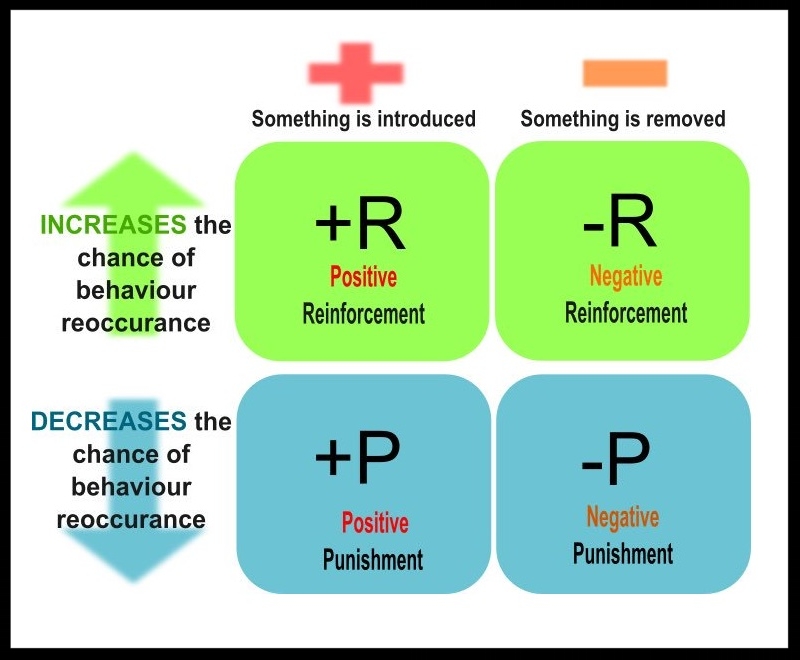
Photo Credit: AP Psychology Twitter
For the purposes of talking about operant conditioning and learning theory, 'positive' simply means 'to add' and 'negative' ways 'to take away'. 'Reinforcement' means that something makes a behavior more likely to happen, and 'punishment' means something that makes a behavior less probable to occur again. And so when nosotros're looking at the 4 means you lot can influence an animal'south behavior, nosotros've got:
-
Positive Reinforcement (R+): adding a stimulus to brand a behavior more than likely to happen over again
-
Negative Reinforcement (R-): removing a stimulus to make a beliefs more likely to happen again
-
Positive Punishment (P+): adding a stimulus to make a beliefs less likely to happen once again
-
Negative Penalization (P-): removing a stimulus to brand a beliefs less likely to happen again
Why Primarily Positive Reinforcement?
Of the four quadrants, positive reinforcement is the all-time method for creating behavioral change in an brute. While all quadrants will alter an animal'southward behavior when utilized correctly, some are frequently unpleasant (like positive punishment), and positive reinforcement is the only quadrant through which you are specifically communicating to the brute yous're training what it needs to do to be successful and rewarding it for making that choice. At that place's no defoliation generated by beingness told what not to do without being given any information near what to do instead, and no brute physical manipulation or stressful handling by the trainer to achieve the behaviors they want. If the animal becomes frustrated or confused, the trainer just goes back to something the animal knows well until the animal is successfully engaged again, and and then goes back to the last footstep of what they were working on before that the animal is confident with. That blazon of interaction builds a strong relationship between the animal and its trainer(s), because the entire experience is designed intentionally to be positive for the animal.
Annihilation an animal values can be a reinforcer, which leaves lots of room for trainers to be creative and consistently modify up what they're rewarding animals with - which makes the whole experience more than engaging and exciting for the participants. Some animals volition do anything for a favorite snack, simply for others a primary reward might be a scratch behind the ears or a take chances to play with a favorite toy. Zoo animals are never deprived of annihilation to encourage them to work for it - instead, reinforcers function like extra special bonuses during the day.
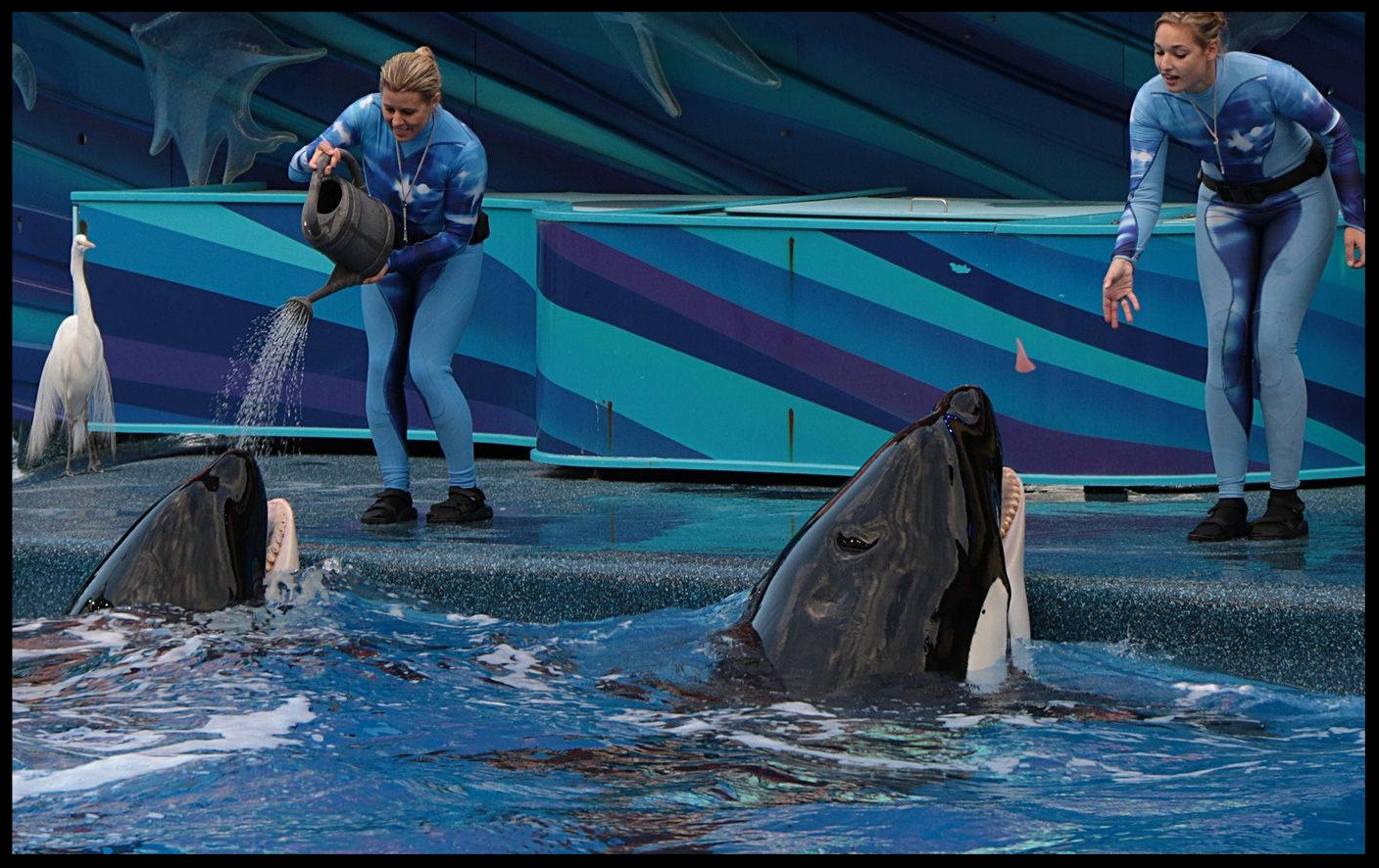
Orcas at SeaWorld Orlando receiving unlike types of reinforcement: the whale on the left is getting a tactile reinforcer in the form of a pouring watering can, whereas the whale on the correct is being tossed a chunk of jello every bit an edible reinforcer.
Photograph Credit: K. Hummel-Uzzi
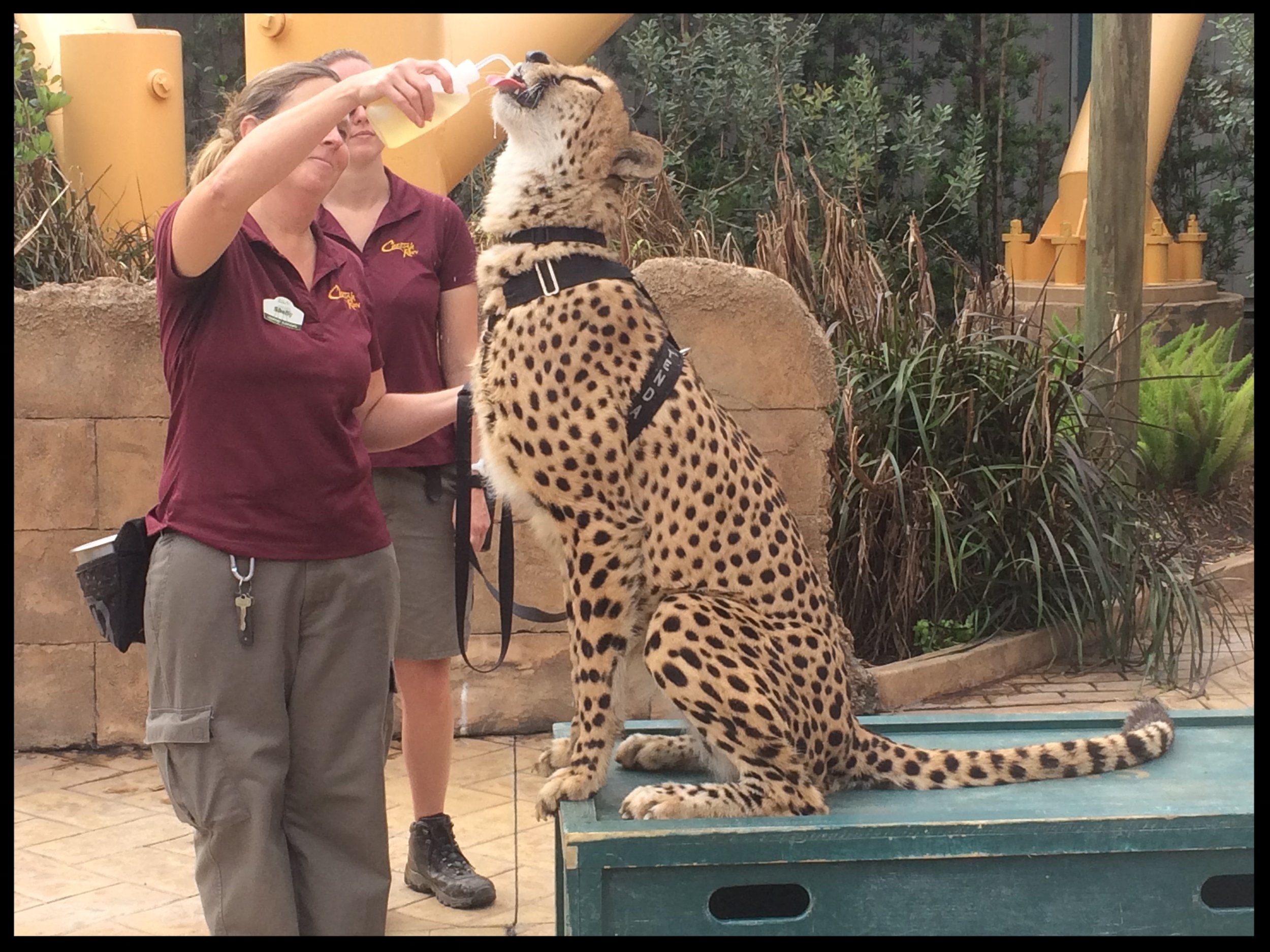
A chetah at Busch Gardens drinks hot chicken broth - his favorite reinforcer - from a squirt canteen during a public demonstaration.
The nigh imporant aspect of using primarily positive reinforcement training is that animals are ever engaging voluntarily. Zoo animal grooming sessions are always prepare so that the animate being chooses if it wants to come up over for the session, and it merely stays as long every bit it feels like engaging. When the creature walks away, the preparation session is done. Well-nigh of the time, animals come up over immediately because they like training: there's a lot of inquiry that shows animals volition choose to work because it's interesting and engaging even when they take everything they already need, and it's the same for grooming sessions. Zoo animals are motivated to engage in grooming by their relationship with their trainer, and the fact that they're doing novel and complicated work while receiving a paycheck in any reinforcer counts equally "currency" for that specific individual. Does this mean that there are some days animals would rather practice other things and but don't engage? Admittedly. And while it may be a footling frustrating for the animate being keepers to not be able to train that twenty-four hour period, that'south only how information technology goes - they feed and care for the animal similar normal, expect until the animal decides they want to come over for a training session, and so use unique and special reinforcers to make information technology super awesome and worth the animal'southward time.
What Kinds of Zoo Animals Tin Be Trained?
The nifty matter about using operant workout techniques for training is that they are able to be generalized to literally whatever species of beast. The quadrants indicate what kind of stimulus needs to be added or removed to a state of affairs to change behavior - it'southward upwardly to the trainer to effigy out what volition exist successful with each species they desire to work with. In order to practice and so, the trainer needs to empathize a lot nearly the natural history of the species they're looking to train, as well as the specific personality and preferences of the private animal they'd be working with.
Some animals, like snakes, consume actually infrequently, so a grooming plan for them has to have into account that food-based reinforcers can but be used at nigh once every couple of days. Either this means that the trainer finds an alternate reinforcer the snake will work for (which doesn't always exist), or they just accept that preparation behaviors with that snake might accept much longer than information technology would with a mammal. And that'southward fine - that's just how snake preparation goes, and zookeepers work with that rather than trying to force it to change.
Other animals might need a modified grooming session because their species (or specific private life history) prevents them from beingness able to perceive the "marking" cue (called a bridge) that trainers employ to tell them when they've completed a beliefs correctly. A flash of light is ofttimes used to bridge fully aquatic or deaf animals, and an old animate being with reduced hearing and sight might have a tactile bridge.
The method of successful reinforcer delivery is also factored into how grooming situations work with different species. Primates can frequently just be handed food directly once they have a expert human relationship with their trainer, but large carnivores are mostly fed meat treats from tongs or a long stick to make certain they don't accidentally have a a finger along with it. Cetacean trainers mostly throw food directly into the open mouths of their animals, but a blind sea panthera leo might crave the food to be touched to her nose so she knows where it is in guild to catch information technology. Fish are by and large fed reinforcers directly from a stick, to ensure the correct brute in the tank actually gets the reinforcer that was meant for it, too every bit to keep backlog food from falling to the bottom and being wasted.
How Does A Normal Grooming Session Go?
The keepers who are training that day will collect all the things they need for the session: a diverseness of reinforcers, whistles or clickers to apply every bit a bridge, tools or props needed for specific behaviors, and any required condom gear for beingness in shut proximity with animals. They'll take the whole kit over to the space designed as a training surface area and get set up, and so telephone call over the creature existence trained. What happens during that session volition depend on a lot of factors: the experience of the trainer, the relationship between the trainers and the animal, and what the current training priorities are, as well every bit potentially how the animal is feeling that day, the behavior of conspecifics, and what the weather is similar.

A selection of things that might be brought to a training session with a cetacean: a bucket of fish, a soft tactile brush, a favorite toy, chunks of unflavored gelatin, and a whistle for employ as a bridge cue.
Long before trainers start actually working on behaviors with an animate being, they have to outset establish a positive relationship with them. This starts just by spending time with the animal, being around at the fence line and then the keeper becomes familiar, and so they might progress to feeding the animal or shadowing their existing trainers during sessions. Once the creature responds to the potential trainer's approach in ways that signal positive excitement and involvement, the person is finally able to starting time working on grooming.

A California sea king of beasts at the Turtle Back Zoo waits as its trainer reaches for a piece of fish during a session.
Photo Credit: Turtle Back Zoo

An opossum at the Nashville zoo waits every bit she is handed a mealworm as a reinforcer.
Photo Credit: J. Belair
New trainers first start by being 'transferred' the behaviors an animal already knows how to practise for other people. This ensures that the new trainer is enlightened of what the fauna has already learned and that what they're doing is consistent with the piece of work of the other trainers. If a new trainer's criteria for a successful behavior is of a sudden different than what the animate being has learned is expected of it, that can be really frustrating for the animal; this can lead to behavioral issues during training sessions or a lack of interest in engaging with training sessions at all. As a upshot, new behaviors are mostly taught by one person or by a small collaborative squad until they're solid, and so slowly all of the animal's other trainers are taught how to ask for and reward it correctly. All "training in" of new people is done at a footstep that ensures that both staff and the animal are comfortable with each step before asking them to keep to the next - this is peculiarly true with any behaviors that involve whatsoever sort of contact betwixt the trainer and their animal, or whatever work washed without barriers between the two. Once any new team member is up to speed with all of the extant behaviors an animal knows, they might get to start working on something new.

A trainer at Tiger Earth demonstrates to a preparation form how to accordingly present a reinforcer to a large carnivore.
In order to work on a new behavior, trainers generally have to draft a formal training plan and submit it to their area atomic number 82 (or the zoo's behavioral husbandry department, if they have one). This volition item the processes through which the behavior will be accomplished and proofed, and what criteria volition exist used to determine when the animal is ready to move onto the side by side step. Sometimes these plans also list types and amounts of reinforcers to exist used during the preparation, so that it tin can exist double-checked that they're appropriate (for example, to brand certain calorie intake is appropriate or to make sure a nutrient a specific animate being tin can't eat isn't accidentally included). Once canonical, the person working on the new beliefs will go along records of their preparation sessions in which they particular everything that happened during the session. These get into the balance of the animal'southward records, so that other team members and direction staff can stay appraised of anything that might be influencing an animal's behavior.
New behaviors are generally taught through a process called shaping, where the trainer starts by cuing a beliefs the animal already knows how to do, so slowly over fourth dimension changes the criteria for getting a reinforcer to something just a little bit closer to the goal behavior. Over fourth dimension, the desired behavior is "shaped" through these gradual approximations.

A keeper at the Twycross Zoo works on an approximation for a voluntary injection behavior with a chimpanzee. Once the animal is comfortable being sitting calmly while existence poked in the shoulder with a finger, the keeper might progress to using a dowel, then a syringe without a needle, then a blunted needle, and finally a sharpened needle that actually gives the chimp a poke.
Photo Credit: Grand. Waller
What Are Zoo Animals Trained To Do?
A successful training plan tin can impact every aspect of a zoo animal's life. A majority of the training zoo animals engage in is geared towards voluntary medical participation, simply trained behaviors also teach animals how to be better mothers, help zookeepers complete their daily routine, allow animals to educate guests through a demonstration, assist in moving animals effectually the facility easily, and are sometimes just a fun and enriching activity for the animal to engage in.
Target Training
I of the start behaviors every zoo brute is taught is "target training." It's a very simple behavior: the animal is asked to bear on a specific body part - oftentimes their nose - to an item that is designated as the "target". Target training is a very primal behavior in zoo training programs because it is a great building cake for shaping near of the other behaviors an animal will larn in its lifetime.
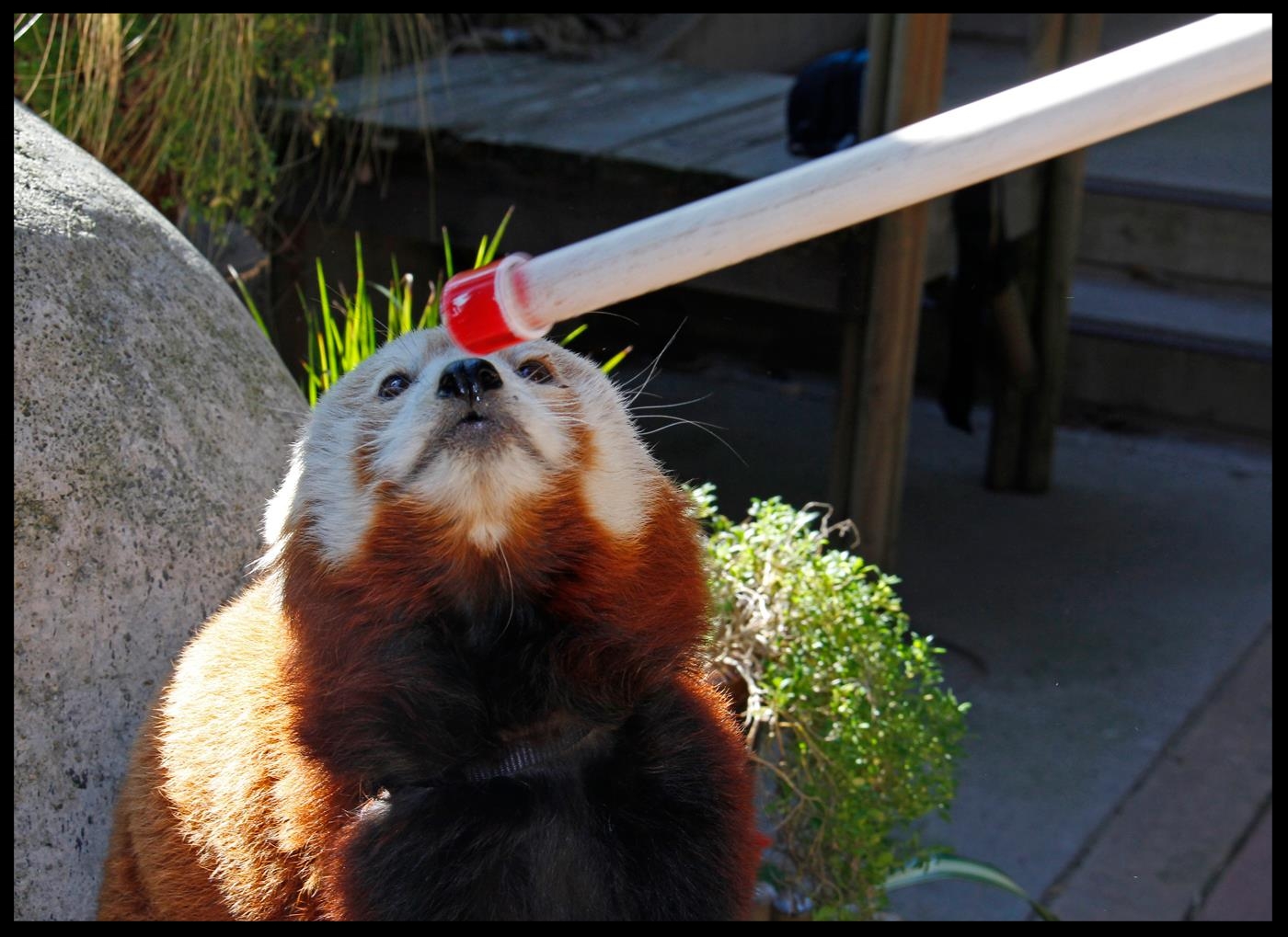
A ruby-red panda at the Sacramento Zoo doing a "nose target" behavior.
Photograph Credit: M. Owyang

An Amur leopard at the Franklin Park Zoo doing a "nose target" beliefs through a grooming wall.
Photo Credit: Franklin Park Zoo

A Bactrian camel at the Franklin Park Zoo doing a "olfactory organ target" at his exhibit argue.
Photo Credit: Franklin Park Zoo
Targets can also be useful for when preparation at a distance, or in the water. A long target pole allows a trainer to cue an animal into a specific position without sharing infinite with them directly, or having to get too close. Cetaceans are frequently directed to a specific area of the pool to perform a behavior through a target pole existence slapped on the water, and target objects hanging higher up the pool on a line are used to shape aerial behaviors.

A Due north American river otter at the Aquarium of the Bay doing a "look" behavior while in position for a
nose target.
Photo Credit: D. Estes

A Commerson's dolphin at Aquatica follows a target pole while learning a "belly flop" behavior.
Photo Credit: G. Hummel-Uzzi

An orca at Six Flags Discovery Kingdom leaps to impact a suspended target with her rostrum.
Photo Credit: M. Owyang
Targeting is a specially useful beliefs to teach aquatic animals, because information technology allows them to be fed directly from a target pole - this allows aquarists to ensure all of the fish in a tank go something to swallow, and lets them mensurate the amount of food each fish is getting.

A lionfish at the Cameron Park Zoo targets to a pole begetting a chunk of fish.
Photo Credit: D. Estes

A moray eel at the Cameron Park Zoo approaches a target pole.
Photograph Credit: D. Estes

A stingray at the Cameron Park Zoo takes a piece of food off of a target pole.
Photo Credit: D. Estes
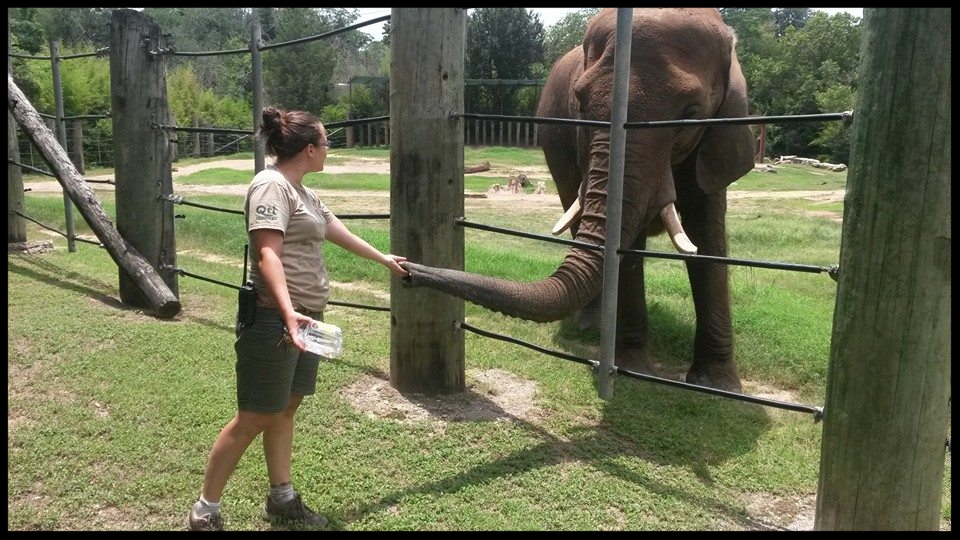
An African elephant at the Cameron Park Zoo doing a "trunk target" behavior to a zookeeper's hand.
Photo Credit: Cameron Park Zoo

A skink at the Franklin Park Zoo doing a "nose target" behavior while on a perch for a public demonastration.
Photograph Credit: C. Rutledge

A half-dozen-banded armadillo doing a "nose target" at the Sacramento Zoo.
Photo Creidt: M. Owyang

A reticulated giraffe at the Turtle Back Zoo doing a "nose target" to a zookeeper's hand.
Photo Credit: Turtle Back Zoo
Station Preparation
Another crucial behavior that zoo animals larn early is chosen a "station." A station is simply a spot where an animate being has been trained to go on cue and stay there. Stations tin be a stump or a perch or even merely a specific spot on the floor. Stations allow trainers to ask animals go to particular locations during a training session, and lets them manage a multiple animal session past asking each animal to sit patiently at its station until information technology is that animate being'south plow to piece of work on a behavior.
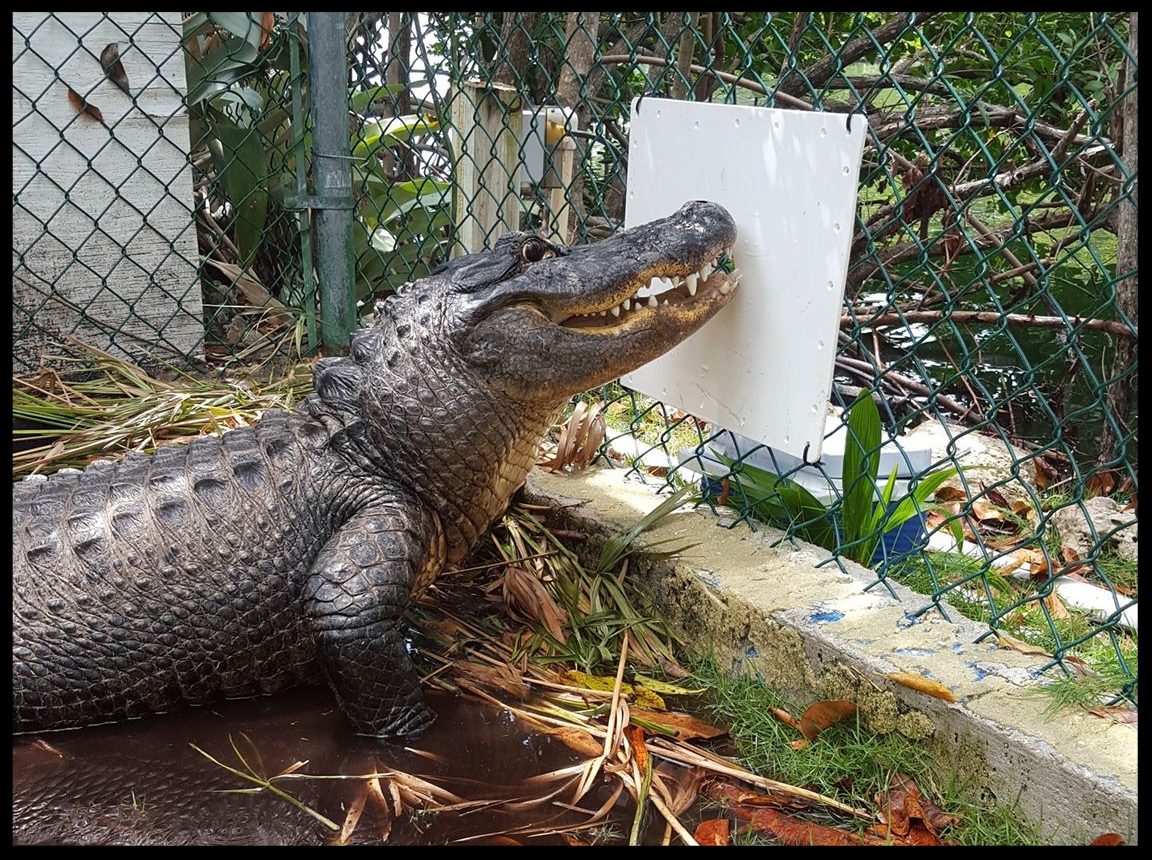
An American Aligator holds at a "command station" while staff at Theater of the Ocean piece of work in his showroom.
Photo Credit: K. Rivera
Open Mouth
Some other really of import and incredibly common beliefs is the "open mouth" cue. It can be done with whatever species that has a rima oris to open up, and is used to allow staff to assess animals' oral health without an invasive procedure. The animal is first taught to open their mouth on cue, and so taught to hold it for a decent elapsing. If an animal's oral fissure or teeth demand medication or frequent care, they'll be asked to stand still and allow bear on and manipulation of their lips and jaws as part of the behavior.

An African lioness at the Houston Zoo doing an "open mouth" beliefs.
Photo Credit: Thousand. Buckley-Jones

A Due north American river otter at the Aquarium of the Bay doing an "open mouth" beliefs while holding a "olfactory organ target" on a target pole.
Photo Credit: D. Estes

A Commerson's dolphin at Aquatica doing an open-rima oris behavior.
Photograph Credit: Thousand. Hummel-Uzzi

An African Elephant at the Atlanta Zoo doing an "open up mouth" behavior with her torso up and so keepers tin run across inside of her mouth hands.
Photo Credit: T. Phillips
Trunk Examinations
Preventative veterinary work requires that zookeepers and veterinary staff are able to go a shut wait at a zoo animate being's body on a regular basis. Many animals in zoos are trained to nowadays dissimilar torso parts to their trainers for exam. Once animals know how to "target", trainers can use that skill to ask animals to nowadays any function of their body to them or position it against a debate for close inspection. Zoo animals are commonly taught to present their feet to trainers, as well as their eyes, ears, stomach, flank, and tail.

A jaguar at the Houston Zoo doing a "trunk presentation" behavior at the exhibit argue, while being reinforced with milk from a squirt bottle.
Photograph Credit: 1000. Buckley-Jones

A tiger at Great Cats Globe Park doing a "trunk presentation" behavior during a demonstration for guests.
Photograph Credit: Great Cats World Park

An African Elephant at the Atlanta Zoo doing a "foot presentation" behavior while a staff member looks at the wellness of her anxiety and toenails.
Photo Credit: T. Phillips
Many exam behaviors too double every bit neat presentation behaviors because they allow guests to get a unique upward-close view of a wild animal's size, teeth, or claws. In one case animals know how to "target", trainers can use that skill to ask animals to present whatsoever office of their body to them or position it against a fence for close inspection . Zoo animals are commonly taught to present their feet to trainers, likewise as their optics, ears, flank, and tail.

A tiger at Tanganyika Wild animals Park doing a "foot presentation" behavior during a public grooming demonstration.
Many of the interactive behaviors zoo guests volition see during aquatic creature presentations, while cute, are actually behaviors the animals have learned for test purposes.

An orca at SeaWorld Orlando doing a "flipper presentation" beliefs during a show.
Photograph Credit: M. Hummel-Uzzi

California Sea Lions at the Brookfield Zoo doing "flipper presentation" behaviors during a daily preparation session.

A blue and gold macaw doing a "wing presentation" behavior at the Chessington World of Adventures Resort.
Photo Credit: L. Partridge
During regular daily training sessions, zoo animals are asked to exercise multiple unlike body presentation behaviors so their keepers can assess their whole trunk for potential injuries.
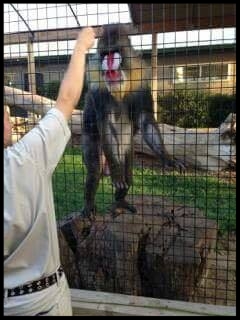
A mandrill at Tanganyika Wild fauna Park doing a "torso presentation" behavior.
Photo Credit: A. Hawkins
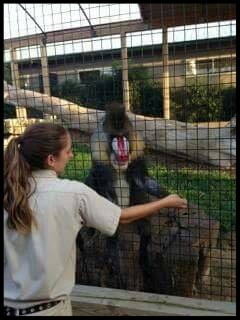
The same mandrill doing a "hand presntation" behavior.
Photo Credit: A. Hawkins

The same mandrill doing an "open mouth" beliefs.
Photograph Credit: A. Hawkins
Medical Care
The benefit of having a really intensive and proactive medical training program is that when animals do get sick or injured and need treatment, they've already learned the skills that volition help expedite their care. Zoos train animals for all sorts of medical procedures, such as blood draws, injections, and ultrasounds, just in case they might need that type of handling someday.

A trainer at Dolphin Quest Bermuda uses a sustained "open rima oris" beliefs to examine a bottlenose dolphin's teeth carefully for wear or impairment.
Photograph Credit: M. Minikin

A greater one-horned rhinoceros at the Los Angeles Zoo was trained to allow the application of a special bandage when her horn became cancerous and had to be removed.
Photo Credit: J. Pham

A white-tailed deer at the Brevard Zoo licks at a fruit smoothie for the duration of a voluntary blood draw.
Photo Credit: R. Smith

A cougar at at America'south Teaching Zoo holds still while claret is drawn from a vein in its tail.
Photo Credit: A. Howland
When animals need more than diagnostics to complete their care, those behaviors are often too trained likewise.

A trainer at SeaWorld Orlando palpates a bottlenose dolphin's bladder in preparation for collecting urine with the syringe held in his other hand. The dolphin has been trained to "station" on the trainer's outstretched legs and so urinate on cue.

A saki monkey working on a voluntary 10-ray behavior at the Elmwood Park Zoo.
Photograph Credit: 1000. Olsen
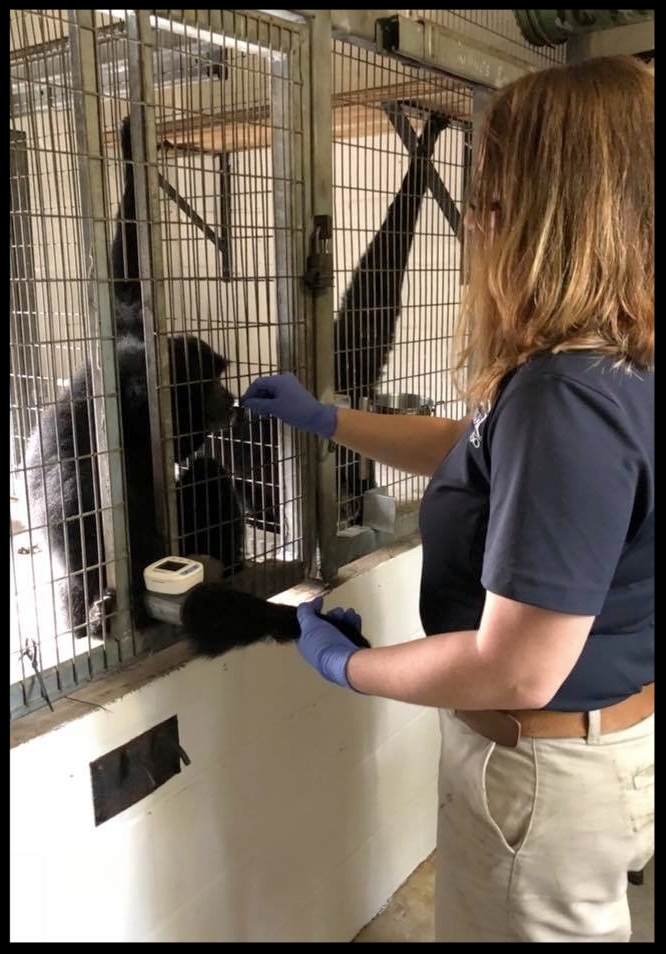
A siamang waits while a keeper takes a claret pressure reading from an arm cuff at the Brevard Zoo.
Photograph Credit: M. Castrucci

An orangutan at the Cameron Park Zoo hangs out while keepers and vet staff assemble information with a three-lead electrocardiogram.
Photo Credit: L. Klutts

A ring-tailed lemur allows a voluntary ultrasound of her belly at the Cameron Park Zoo.
Photo Credit: L. Klutts
Any animals with on-going health issues (such as arthritis or skin issues) volition exist trained to accept a daily dose of the appropriate medicine, or to allow staff to apply treatments topically.

A trainer at the Downtown Aquarium in Denver demonstrates how they apply medication to a Northward American river otter'southward hind feet through the utilize of a "nose target" and a "scroll over" behavior.

A coatimundi at the Chessington World Park and Resort practices taking medicine from a syringe.
Photo Credit: 50. Partridge

A Harris's hawk at the Texas Land Aquarium holds a "beak target" behavior to 1 trainer's mitt, every bit another prepares to put ointment on his middle. The hawk has been trained to put his caput through a hole in the side of a carrying crate for this procedure.
Photo Credit: A. Henry

A keeper at the Twycross Zoo trains a mother orangutan to let her requite her babe oral medication through cooperative feeding.
Photo Credit: Chiliad. Waller

An American Crocodile waits at a "station" on dry land at the Theater of the Sea while a topical treatment sinks into its foot.
Photo Credit: Thou. Rivera
Voluntary engagement in medical behaviors is an important part of all zoo animals' care, merely a truly crucial aspect of successfully managing the largest zoo residents. Smaller animals tin can exist physically restrained for medical care in an emergency situation, but an elephant is practically impossible to treat if it decides it doesn't want to cooperate.

An orca at SeaWorld Orlando "stations" on a scale so trainers can record her weight.
Photo Credit: M. Hummel-Uzzi

A black rhino at Zoo Atlanta stands patiently while a veterinary ultrasounds her abodmen to check for a successful pregnancy.

An American Alligator at Theater of the Sea climbs onto a stationary scale.
Physical Therapy and Exercise
In addition to helping animals while they're sick, a skilful training program helps animals with the recovery process after an injury and also keeps them in strong and in shape.

A dromedary camel at a zoo in Kentucky stretching into a "olfactory organ target" beliefs as role of concrete therapy for his stiff cervix.

The aforementioned dromedary camel allowing leg manipulation past his trainer as part of his PT.

The aforementioned dromedary camel following a "nose target" into a another deep stretch during PT for his stiff neck.

An Asian elephant at the National Zoo doing a "bow" behavior during a public sit-in. This behavior is a good stretch and helps keep elephants limber.

An African elephant at the Birmingham Zoo working on a "salute" behavior. This behavior requires both strength and balance, and is a complicated beliefs to learn that provides the elephants with mental enrichment.
Photograph Credit: B. Beury
Getting Around the Zoo
Zoo animals will oftentimes need to travel to other parts of the zoo - to a new exhibit, to the vet, to a public presentation, or even off-grounds - and it's easier for everyone if they're already trained for send so that they stay calm and comfy during the process.
The most common type of ship preparation is called "crate preparation" and it's as simple every bit it sounds - the animal is rewarded for voluntarily entering and spending time in a travel-sized carrier. The animals first get comfortable with the door beingness open, then with it close for progressively longer duration, and so finally with it being moved. Crate preparation helps to reduce stress during transport because the animal is getting to choose to enter a infinite information technology has a long history of positive experiences with.

Fulvous Whistling Ducks at the Sacramento Zoo entering their transport crate.
Photo Credit: M. Owyang

The same Fulvous Whistling Ducks calmly settled inside their transport crate en road to a presentation.
Photo Credit: 1000. Owyang
Crate training also provides a safe way for zoo staff to interact with potentially dangerous or aggressive animals. Stationary crates are often outfitted with doors that allow trainers to access specific parts of an animal'south body without putting themselves too close to claws or beaks. One trainer volition work with the creature, reinforcing them for staying in the crate and keeping calm, while another utilizes the access doors to examine or care for the necessary area. Crate preparation is also often the least-stressful way to sedate an brute that needs major medical treatment - they can exist injected with a allaying while in an safe, enclosed infinite then transported to the veterinary infirmary in that same crate.

A double-wattled cassowary at the Birmingham Zoo waits within his crate for his trainer to evangelize a favorite reinforcer. This crate allows keeper staff to piece of work with him at close range while keeping a solid barrier between them and his stiff, heavily clawed feet at all times.
Photograph Credit: Birmingham Zoo
Another option for moving animals is to merely railroad train them to vesture a harness and to walk adjacent to their trainers on a leash. This is a training type used more frequently for ambassador animals that are specifically trained to take part in educational demonstrations and outreach programs. Harness training is a long, gradual process that involves getting the animal comfortable with putting on and wearing the harness, as well every bit educational activity them how to follow a trainer from point A to signal B, before they ever go out their enclosure.

A crimson panda at the Sacramento Zoo waits on a walk while wearing a harness on the style to a public programme.
Photograph Credit: M. Owyang

A harnessed aardvark at Omaha's Henry Doorley Zoo digs upward the zoo grounds on a walk while her trainers do an informal education session with zoo guests.

A cheetah at Busch Gardens follows a "nose target" cue up onto a platform during a public demonstration.
While many zoo animals only wearable harnesses for the purpose of taking part in specific programming, getting to go along cocky-directed walks simply to explore the zoo grounds is a form of environmental enrichment for others.

A ruby river hog at the Cincinnati Zoo stops to sniff the breeze while exploring the zoo grounds wearing his harness.
Photo Credit: Grand. Meeker

A serval at the Nashville zoo explores the facility grounds with a trainer on a snowy morning.
Photo Credit: C. Wheeler

A harness-trained emu is walked through the grounds of the Staten Isle Zoo by its trainer.
Photo Credit: R. Ayers
Some zoo animals are taught to travel with or to fly to trainers entirely without wearing gear. This is generally a do maintained with flighted birds that take part in public demonstrations, just sometimes it's a technique used with other types of animals.

A juvenile black crowned crane at Natural Encounters learns to walk alongside its trainer without a harness or leash.
Photograph Credit: Chiliad. Davies

A giant Indian fruit bat at Six Flags Discovery Kingdom practices flight from a perch to the arm of his trainer.
Photo Credit: M. Hyde
Acting On Cue for Education
Well-nigh zoo animals have an incredible range of unique and specialized behaviors that are a major office of their species' survival and success in the wild. One major use of training in zoos is putting those behaviors on cue so that guests tin can learn almost species-specific adaptations by seeing them showtime-hand. These are the behaviors you'll see the most of in educational demonstrations and outreach programming, although often they'll exist interspersed with medical behaviors or body presentations likewise.

A coatimundi at the Chessington Globe of Adventures Resort demonstrates the species' agility and climbing ability by running beyond a rope upside-downward.
Photograph Credit: Fifty. Partridge

An Amazon parrot at the Chessington World of Adventures Resort shows off its flying skills ..
Photo Credit: L. Partridge

A meerkat shows off the species' natural "sentry" behavior at the Chessington Globe of Adventures Resort.
Photograph Credit: L. Partridge

A tamandua at Six Flags Earth Park demonstrates how potent a tail the species has by hanging from it.
Photo Credit: A. Hawkins

A blue and gold macaw hangs by its beak during an educational presentation at the Chessington Globe of Adventures Resort.
Photo Credit: L. Partridge

A California sea lion shows off forcefulness and stamina by doing a "flipper stand" at the Chessington World of Adventures Resort.
Photo Credit: 50. Partridge

The same California body of water lion engages in a "stretch" behavior to prove off the species' range of move and flexibility at the Chessington World of Adventures Resort.
Photograph Credit: L. Partridge

Demonstrating the incredible bird-hunting skills of its species, a serval jumps for a lure during programming at the Columbus Zoo.
Photograph Credit: Katie Fox
Sometimes the natural or adaptive behaviors put on cue are not exactly what guests expect to see at a zoo, but are important things to show the public as part of specific types of messaging: information technology's common to run into parrots screaming on cue to assist explicate why they don't brand good pets, or urban wildlife demonstrating exactly how proficient they are at getting into unsecured trash.

A raccoon at the Chessington World of Adventures Resort demonstrates how easily it is able to get into a typical trash bin during an educational demonstration.
Photo Credit: L. Partridge

The same raccoon poses for photos in the trash can after the demonstration ended.
Photo Credit: L. Partridge
Sometimes, even "unnatural" behaviors tin really get people to engage with specific types of messaging. It's currently very popular to have presentation animals demonstrate environmentally-witting behaviors the zoo is encouraging guests to start doing, such as recycling.

A California bounding main lion at the Chessington Globe of Adventures Resort places a plastic canteen into a recycling bin during an educational presentation.
Photo Credit: L. Partridge
Airheaded Things
The procedure of grooming - learning new behaviors, figuring out ways to combine old behaviors, or practicing something that's physically challenging - is a really good type of ecology enrichment for all animals in human care. To keep their animals engaged and learning new, novel things all the time, zoos will oftentimes offer animals the adventure to learn fun or silly behaviors. The animals aren't forced to larn any of them: if an beast isn't interested in grooming on a behavior that isn't crucial to their medical care or husbandry, trainers will let it driblet, and discover something else that the animals finds more than engaging to learn or do instead. Nevertheless, lots of animals eagerly appoint with these behaviors and sometimes even prefer to do them over their other trained behaviors.

A bottlenose dolphin at SeaWorld Orlando sticks her tongue out in response to a "joke" cue from her trainer.

A California bounding main king of beasts at the Chessington Globe of Adventures Resort hides its face in response to a "look guilty" cue during a presentation.
Photo Credit: L. Partridge

A blue and gold macaw at the Chessington World of Adventures Resort holds a clicker and shows guests that he knows how to bridge himself during his own training session.
Photograph Credit: L. Partridge
Interaction
Guests visit a zoo because they honey animals and desire to learn about them and run into them upwards close. Historically, zoos have allowed guests to collaborate with animals whether the animals wanted it or not; modern zoos, understanding how much it makes a visitor's twenty-four hours to actually go to collaborate with a zoo creature, have switched to allowing interactions with specifically trained animals - and but when the animals feel similar information technology.
For most interaction behaviors, the animal is specifically taught to practise a certain beliefs with people other than its normal trainers (generally, a olfactory organ or paw target, but sometimes it's just taking food from them). Visitors are brought to a specific interaction area and the animal is offered the option of engaging with them in render for very high-value reinforcers. If the animal doesn't cull to come up do the interaction that 24-hour interval, or appears to be uncomfortable, the trainers running the session allow the beast to make that selection and explain to the guests why voluntary engagement is such a crucial function of succesful animal preparation.

A North American river otter doing a "nose target" behavior to a target pole held past guests during a special behind-the-scenes interaction prgoram.

A greyness fox at the Sacramento Zoo "loftier-fives" his trainer on cue.
Photo Credit: M. Owyang

A Due north American River Otter at the Aquarium of the Bay holds a "nose target" beliefs while presenting his mitt for a tactile behavior.
Photo Credit: Aquarium of the Bay

An American Alligator "painting" on a sheet during an interaction program at Theater of the Sea.
Photo Credit: K. Rivera

A green aracari at the Nashville Zoo is cued to hop across guests' artillery during a public presentation.
Photo Credit: Nashville Zoo

A California ocean king of beasts is cued to wave at a small kid at the Turtle Back Zoo's underwater interaction window.
Photograph Credit: Turtle Dorsum Zoo
This is only a short overview of all the different ways operant conditioning training is used in zoos to help keep animals healthy, active, and engaged. Some of the things zoo animals have learned to do in recent years are spectacular. If you tin can imagine a behavior that might exist benign to managing exotic animals, there's probably a zoo out there that has trained it. The best fashion to learn more is to follow the social media of your local zoological facility, because they dear to showcase innovative training and fauna breakthroughs in posts for the public.
Read More than Articles from Why Animals Practice The Thing:

Sometimes, when you visit a zoo, at that place'south seemly random stuff in the exhibits for animals to interact with: these "toys" given to the animals are part of a carefully structured program that keeps animals agile and engaged.


RACHEL GARNER

Rachel is an educator and beast science writer. With prior professional feel in zookeeping, visitor education, shelter behavior management, and more, she works to translate pertinent field-specific knowledge into comprehensive explanations about current animal related topics.
Source: https://www.whyanimalsdothething.com/how-to-understand-zoo-animal-training
Posted by: hildebrandjould1992.blogspot.com

0 Response to "How Long Would It Take To Train Animals For A Zookeeper"
Post a Comment